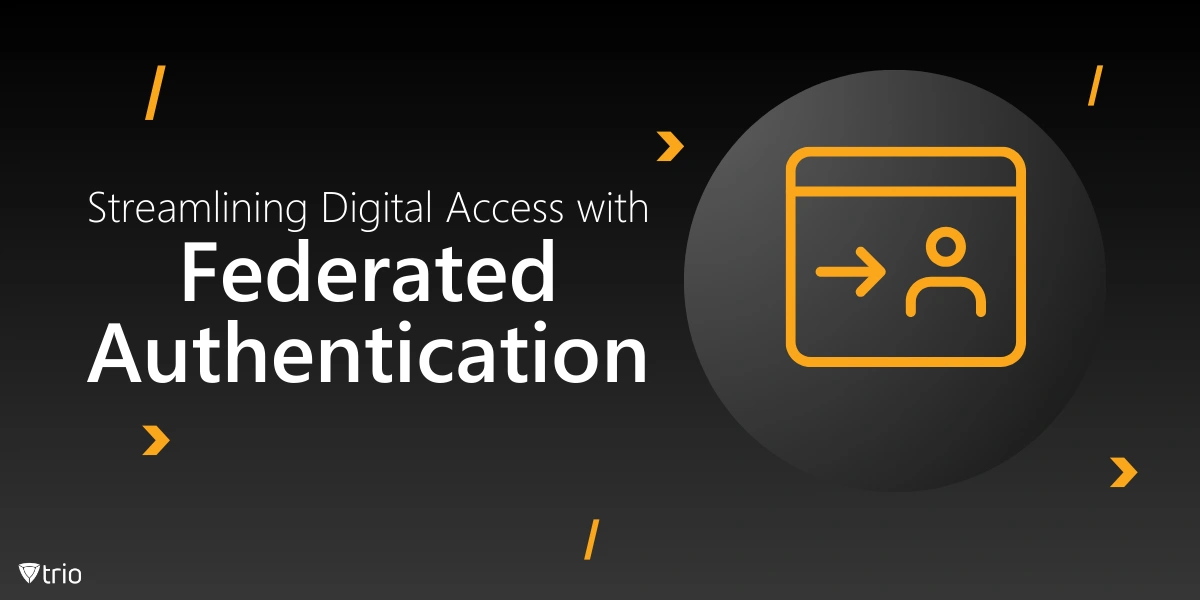Businesses are constantly seeking ways to enhance the security and user-friendliness of their applications, websites, and user interfaces. As the demand for seamless access across multiple platforms grows, innovative solutions like federated authentication have emerged as game-changers. This comprehensive guide delves into the intricacies of federated authentication, exploring its underlying technology, implementation strategies, and far-reaching benefits.
The Essence of Federated Authentication
Federated authentication, also known as identity federation or identity management federation, is a revolutionary approach that enables users to access various digital environments using a single set of credentials from a trusted platform. It's a "one-size-fits-all" solution that streamlines the authentication process, eliminating the need for multiple logins and password management hassles.
At its core, federated authentication relies on trust relationships between entities called federations. These federations establish a network of trust, allowing users to seamlessly navigate across different domains and applications without the need for redundant authentication. This innovative concept has gained significant traction as businesses strive to enhance security while improving the overall user experience.
Decoding the Terminology
To fully comprehend the realm of federated authentication, it's essential to understand the key terminology associated with this technology:
Federated Authentication (Fed Auth): This term refers to the process of using a single authentication event to gain access to multiple systems or services across different domains. It's akin to possessing a master key that unlocks various locks.
Federated Identity Management (FIM): FIM is a broader concept that encompasses the management of user identities and their permissions across different systems and organizations. It encompasses elements of authentication, authorization, and trust relationships between entities.
Identity Provider (IdP): An IdP is a trusted entity responsible for creating and managing user credentials. It plays a crucial role in authenticating users and validating their identities.
Service Provider (SP): An SP refers to the website, application, or service that a user is attempting to access. It relies on the IdP to authenticate the user and grant access based on the established trust relationship.
Federated Authentication vs. Single Sign-On (SSO)
While federated authentication and single sign-on (SSO) share similarities, it's important to understand their distinctions. SSO allows users to access multiple applications or services within a single domain or organization using a single set of credentials. On the other hand, federated authentication enables users to access resources across multiple domains or organizations that are part of the federated group.
In essence, every instance of SSO can be considered a form of federated authentication, but not all federated authentication scenarios are classified as SSO. SSO is typically tied to enterprise environments, while federated authentication has broader applicability across various domains and organizations.
The Mechanics of Federated Authentication
To grasp the inner workings of federated authentication, it's crucial to understand the interplay between the key components: the user, the IdP, and the SP.
- User Initiates Access: The process begins when a user attempts to log in to an application or service provided by the SP.
- Authentication Request: The SP sends an authentication request to the IdP, seeking verification of the user's identity.
- Identity Validation: The IdP authenticates the user's identity by verifying their credentials stored in its database.
- Access Granted: Upon successful authentication, the IdP sends a confirmation to the SP, granting the user access to the requested application or service.
This seamless authentication process allows users to navigate multiple applications and services without the need for redundant logins, enhancing productivity and user satisfaction.
Protocols Powering Federated Authentication
Federated authentication relies on standardized protocols to facilitate communication and ensure interoperability between the IdP and the SP. The most commonly used protocols in this domain include:
Security Assertion Markup Language (SAML): SAML uses Extensible Markup Language (XML) to standardize the communication of identity data between web-based IdPs and SPs. It simplifies password management and user authentication in a federated system.
Open Authorization (OAuth): OAuth is an authorization protocol that grants access to third-party services without requiring users to share their credentials. It uses JSON Web Tokens (JWT) to securely authorize access.
OpenID Connect (OIDC): OIDC is an identity layer built on top of OAuth 2.0, designed to authenticate users with enhanced security through strong encryption and broader applicability across various applications.
These protocols work in harmony, enabling a wide range of customer applications to leverage the benefits of federated authentication services. The best solutions support multiple protocols to cater to diverse business needs and ensure seamless integration.

Real-World Federated Authentication Examples
Federated authentication has become a ubiquitous part of our digital lives, often without us realizing it. One of the most widely recognized examples is logging into third-party websites or applications using personal or professional credentials from trusted providers like Google, Apple, or Microsoft. This streamlined process relies on the trust relationship between the application and the federated partner, eliminating the need for creating new accounts and managing multiple passwords.
Another common scenario is when employees within an organization can access various internal systems, such as email, project management tools, and collaboration platforms, using their company credentials. This federated approach enhances productivity and reduces the burden of managing multiple logins for different applications.
Benefits of Embracing Federated Authentication
Implementing federated authentication solutions offers numerous advantages for businesses and users alike:
Enhanced Security: By reducing the number of login points and centralizing authentication, federated authentication minimizes the risk of unauthorized access and potential hacking attempts.
Improved User Experience: Users no longer need to memorize multiple sets of credentials or go through repetitive login processes, leading to increased convenience and satisfaction.
Simplified User Provisioning: Federated identity enables single-point provisioning, making it easier to grant access to users outside the traditional enterprise perimeter.
Secure Resource Sharing: Organizations within a federated group can effectively share information and resources without compromising user credentials or security.
Cost Savings: By leveraging federated authentication, businesses can eliminate the need to develop and maintain their own single sign-on (SSO) solutions, resulting in significant cost savings.
Streamlined Data Management: With user data stored and managed by the IdP, organizations can simplify their data management processes and reduce the associated complexities.
Federated Authentication vs. Traditional Authentication
While traditional authentication methods rely on individual user accounts and credentials for each application or service, federated authentication offers a more efficient and secure approach. By leveraging trust relationships and centralized identity management, federated authentication eliminates the need for redundant logins and password management across multiple platforms.
In contrast to traditional authentication, federated authentication:
- Provides a seamless user experience by allowing access to multiple services with a single set of credentials.
- Enhances security by reducing the number of potential entry points for unauthorized access.
- Simplifies user provisioning and access management across different domains and organizations.
- Enables secure resource sharing and collaboration within federated groups.
- Reduces the overall cost and complexity associated with maintaining multiple authentication systems.
Embracing Federated Service Solutions: Trio MDM
In the realm of federated authentication, Trio MDM (Mobile Device Management) stands as a powerful solution, enabling businesses to streamline device management and enhance security across their mobile workforce. By leveraging federated authentication, Trio MDM simplifies the process of granting access to authorized users, ensuring seamless integration with existing identity management systems.
With Trio MDM, organizations can:
- Implement robust access controls and authentication mechanisms for mobile devices, ensuring only authorized personnel can access sensitive data and applications.
- Centrally manage and enforce security policies, minimizing the risk of data breaches and unauthorized access.
- Provide a seamless user experience by allowing employees to access corporate resources and applications using their existing credentials, eliminating the need for multiple logins.
- Streamline device provisioning and deployment, reducing the administrative overhead associated with managing a diverse mobile workforce.
To experience the transformative power of Trio MDM and explore its federated authentication capabilities, we invite you to sign up for a free demo. Our experts will guide you through the process, showcasing how Trio MDM can enhance your organization's security posture while improving productivity and user satisfaction.
Conclusion: Embracing the Future of Secure Digital Access
Federated authentication has emerged as a game-changing solution that addresses the growing need for secure and seamless access across multiple platforms. By leveraging trust relationships and centralized identity management, this innovative approach streamlines the authentication process, enhances security, and improves the overall user experience.
As businesses continue to embrace digital transformation, the adoption of federated authentication solutions becomes increasingly crucial. By eliminating the burden of managing multiple logins and passwords, organizations can foster a more productive and secure environment, enabling their workforce to focus on core business objectives.
Whether you're a small business or a large enterprise, embracing federated authentication can unlock a world of possibilities, empowering you to navigate the digital realm with confidence and efficiency. Explore the various federated service solutions available and embark on a journey towards a future where secure digital access is just a single authentication event away.
Get Ahead of the Curve
Every organization today needs a solution to automate time-consuming tasks and strengthen security.
Without the right tools, manual processes drain resources and leave gaps in protection. Trio MDM is designed to solve this problem, automating key tasks, boosting security, and ensuring compliance with ease.
Don't let inefficiencies hold you back. Learn how Trio MDM can revolutionize your IT operations or request a free trial today!





